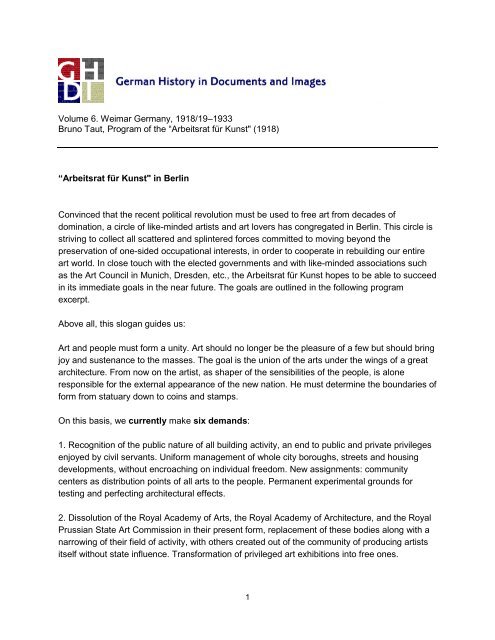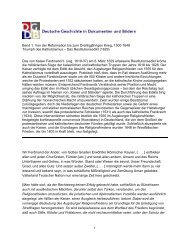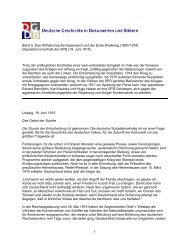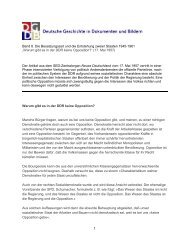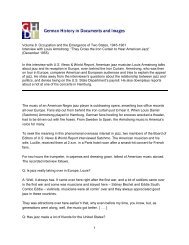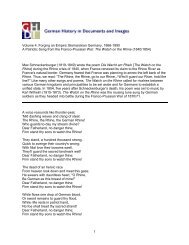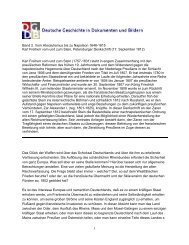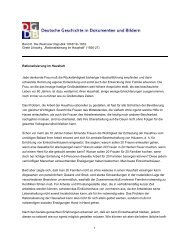print version - German History in Documents and Images
print version - German History in Documents and Images
print version - German History in Documents and Images
You also want an ePaper? Increase the reach of your titles
YUMPU automatically turns print PDFs into web optimized ePapers that Google loves.
Volume 6. Weimar <strong>German</strong>y, 1918/19–1933<br />
Bruno Taut, Program of the “Arbeitsrat für Kunst" (1918)<br />
“Arbeitsrat für Kunst" <strong>in</strong> Berl<strong>in</strong><br />
Conv<strong>in</strong>ced that the recent political revolution must be used to free art from decades of<br />
dom<strong>in</strong>ation, a circle of like-m<strong>in</strong>ded artists <strong>and</strong> art lovers has congregated <strong>in</strong> Berl<strong>in</strong>. This circle is<br />
striv<strong>in</strong>g to collect all scattered <strong>and</strong> spl<strong>in</strong>tered forces committed to mov<strong>in</strong>g beyond the<br />
preservation of one-sided occupational <strong>in</strong>terests, <strong>in</strong> order to cooperate <strong>in</strong> rebuild<strong>in</strong>g our entire<br />
art world. In close touch with the elected governments <strong>and</strong> with like-m<strong>in</strong>ded associations such<br />
as the Art Council <strong>in</strong> Munich, Dresden, etc., the Arbeitsrat für Kunst hopes to be able to succeed<br />
<strong>in</strong> its immediate goals <strong>in</strong> the near future. The goals are outl<strong>in</strong>ed <strong>in</strong> the follow<strong>in</strong>g program<br />
excerpt.<br />
Above all, this slogan guides us:<br />
Art <strong>and</strong> people must form a unity. Art should no longer be the pleasure of a few but should br<strong>in</strong>g<br />
joy <strong>and</strong> sustenance to the masses. The goal is the union of the arts under the w<strong>in</strong>gs of a great<br />
architecture. From now on the artist, as shaper of the sensibilities of the people, is alone<br />
responsible for the external appearance of the new nation. He must determ<strong>in</strong>e the boundaries of<br />
form from statuary down to co<strong>in</strong>s <strong>and</strong> stamps.<br />
On this basis, we currently make six dem<strong>and</strong>s:<br />
1. Recognition of the public nature of all build<strong>in</strong>g activity, an end to public <strong>and</strong> private privileges<br />
enjoyed by civil servants. Uniform management of whole city boroughs, streets <strong>and</strong> hous<strong>in</strong>g<br />
developments, without encroach<strong>in</strong>g on <strong>in</strong>dividual freedom. New assignments: community<br />
centers as distribution po<strong>in</strong>ts of all arts to the people. Permanent experimental grounds for<br />
test<strong>in</strong>g <strong>and</strong> perfect<strong>in</strong>g architectural effects.<br />
2. Dissolution of the Royal Academy of Arts, the Royal Academy of Architecture, <strong>and</strong> the Royal<br />
Prussian State Art Commission <strong>in</strong> their present form, replacement of these bodies along with a<br />
narrow<strong>in</strong>g of their field of activity, with others created out of the community of produc<strong>in</strong>g artists<br />
itself without state <strong>in</strong>fluence. Transformation of privileged art exhibitions <strong>in</strong>to free ones.<br />
1
3. Freedom for all education <strong>in</strong> architecture, sculpture, pa<strong>in</strong>t<strong>in</strong>g, <strong>and</strong> crafts from government<br />
dom<strong>in</strong>ation. Transformation of arts <strong>and</strong> crafts education from the ground up. Allocation of<br />
government funds for this purpose <strong>and</strong> for masters’ education <strong>in</strong> teach<strong>in</strong>g workshops.<br />
4. Vitalization of museums as places of education for the people. Establishment of constantly<br />
chang<strong>in</strong>g exhibitions, made accessible to all the people through lectures <strong>and</strong> guided tours.<br />
Withdrawal of scientific materials <strong>in</strong>to build<strong>in</strong>gs appropriate for them. Segregation of technically<br />
organized study collections for craftsmen work<strong>in</strong>g <strong>in</strong> artistic crafts. Fair distribution of<br />
government funds for acquisition of old <strong>and</strong> new works.<br />
5. Elim<strong>in</strong>ation of all monuments without artistic value as well as build<strong>in</strong>gs whose artistic value is<br />
disproportionate to the value of their materials, which might be made use of <strong>in</strong> other ways.<br />
Prevention of construction of hastily planned war monuments <strong>and</strong> immediate stoppage of work<br />
on the war museums planned <strong>in</strong> Berl<strong>in</strong> <strong>and</strong> elsewhere <strong>in</strong> the nation.<br />
6. Organization of a government department to ensure promotion of art with<strong>in</strong> the framework of<br />
future lawmak<strong>in</strong>g.<br />
The follow<strong>in</strong>g signed this proclamation: Otto Bartn<strong>in</strong>g, Rudolf Bauer, W. C. Behrendt, Joseph<br />
Bloch, Theo v. Brockhusen, A. E. Br<strong>in</strong>ckmann, He<strong>in</strong>z Braune, Ewald Dülberg, Mart<strong>in</strong> Elässer,<br />
August Grisebach, Walter Gropius, Wilhem Hausenste<strong>in</strong>, Franz Heckendorf, Carl Georg Heise,<br />
Fritz Hellwag, Ernst Herzfeld, Willy Jaeckel, Walter Kaesbach, César Kle<strong>in</strong>, Käthe Kollwitz, Leo<br />
v. König, Bruno Krauskopf, Mechtilde Lichnowsky, Paul Mebes, Hans Meid, Herbert Mueller,<br />
Julius Meier-Graefe, He<strong>in</strong>rich Nauen, Wilhelm Niemeyer, Rudolf Oldenbourg, Karl Ernst<br />
Osthaus, Friedrich Paulsen, Max Pechste<strong>in</strong>, Friedrich Perzynski, Hans Poelzig, E. Pottner,<br />
He<strong>in</strong>rich Richter, Chr. Rohlfs, John Schikowski, E. E. Schlieper, Paul Schmitthenner, Hermann<br />
Schmitz, Rich. L. F. Schulz, Erik-Ernst Schwabach, Preuß. F<strong>in</strong>anzm<strong>in</strong>ister Hugo Simon, Milly<br />
Steger, Georg Swarzenski, Georg Tappert, Bruno Taut, Max Taut, He<strong>in</strong>rich Tessenow, Arnold<br />
Topp, Wilhelm R. Valent<strong>in</strong>er, Hermann Voß, Ludwig Wolde, Wilhelm Worr<strong>in</strong>ger—Declarations of<br />
support are requested at the Arbeitsrat für Kunst, Berl<strong>in</strong> NW40, #19.<br />
Source of English translation: Rose-Carol Washton Long, ed., <strong>German</strong> Expressionism,<br />
<strong>Documents</strong> from the End of the Wilhelm<strong>in</strong>e Empire to the Rise of National Socialism. Berkeley,<br />
Los Angeles, London: University of California Press, 1993, pp. 193-94.<br />
Source of orig<strong>in</strong>al <strong>German</strong> text: Bruno Taut, “Arbeitsrat für Kunst <strong>in</strong> Berl<strong>in</strong>," Mitteilungen des<br />
deutschen Werkbundes, no. 4 (1918), pp. 14-15.<br />
2


